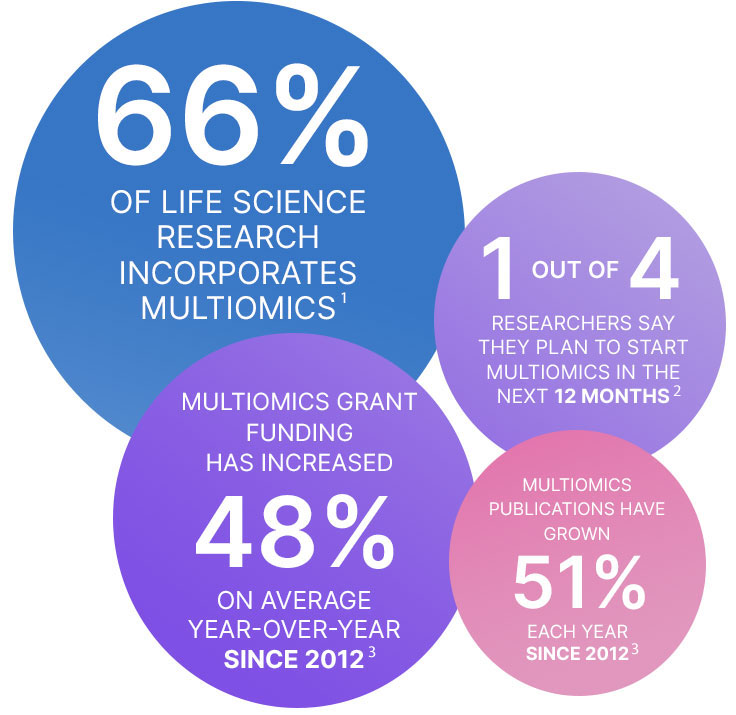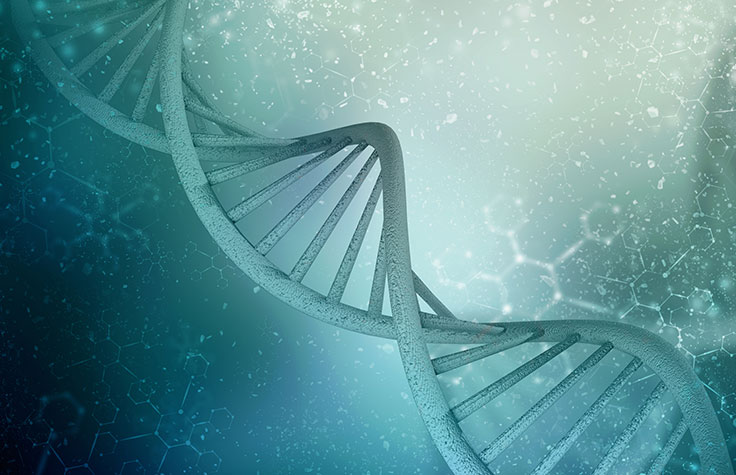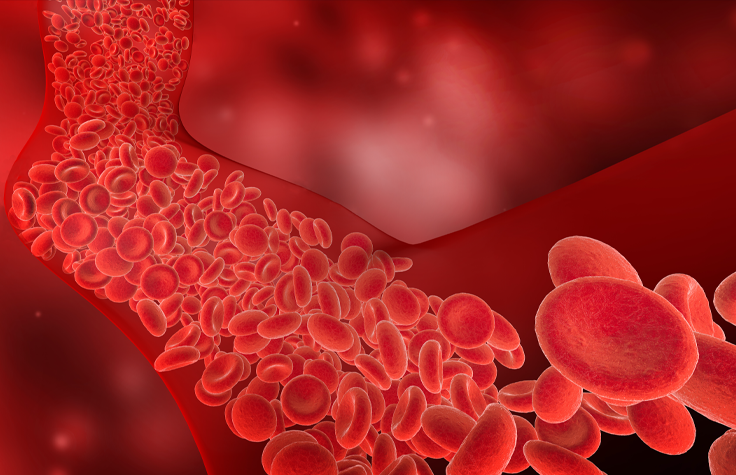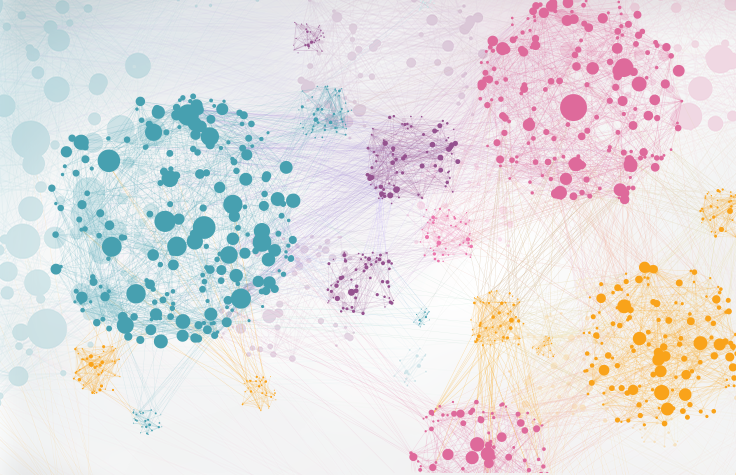What is Multiomics?
Multiomics (multiple omics) provides an integrated perspective to power discovery across multiple levels of biology. This biological analysis approach combines genomic data with data from other modalities such as transcriptomics, epigenetics, and proteomics, to measure gene expression, gene activation, and protein levels.
Multiomics profiling studies enable a more comprehensive understanding of molecular changes contributing to normal development, cellular response, and disease. Using integrative omics technologies, researchers can better connect genotype to phenotype and fuel the discovery of novel drug targets and biomarkers.

Multiomics Multiplies Your Discovery Power
See how you can use multiomics to better connect genotype to phenotype and obtain a full cellular readout not found through single omics approaches.
Learn About Multiomics at a Glance
Popular Omics Profiling Techniques & Technologies
| Approach | Definition | Common Technologies & Techniques |
|---|---|---|
| Genomics |
|
|
| Epigenetics |
|
|
| Transcriptomics |
|
|
| Proteomics |
|
|

Why Adopt Multiomics?
Multiomics offers the following benefits:
- It allows researchers to directly measure causes and consequences of biological phenotypes, rather than make inferences from incomplete data.
- It helps researchers better connect genotype to phenotype, providing scientific insights that cannot be found from single omics methods alone and helping to fuel the discovery of novel drug discovery targets.
- It multiplies discovery power and provides a more holistic view of biological systems by allowing researchers to witness the complicated interplay between the molecules of life.
Multiomics is also becoming more accessible. The cost of high-throughput sequencing (price/Gb) has decreased by >90% over the past decade. At the same time, grant funding has increased for multiomic studies (since 2012, there has been a 48% average year-over-year increase in the number of active or starting grants for multiomics studies).
Top 5 Multiomics Profiling Approaches
Genomics + Transcriptomics
Incorporating RNA-Seq can help researchers annotate and prioritize variants for functional analysis to understand mechanisms of disease. A multiomics approach to functional genomics can help power drug target identification and biomarker discovery.
Genomics + Epigenetics
Comprehensive epigenetic profiling can reveal patterns of gene regulation to help find the function of variants identified by GWAS. Multiomics approaches that combine methylation or other epigenetic profiling with genetic information can connect functional layers to decipher complex pathways and disease mechanisms.
Genomics + Epigenetics + Transcriptomics
The integration of genomics plus epigenetics and RNA-Seq can help researchers identify candidate genes and understand the mechanisms controlling interesting phenotypes. This holistic, non-biased multiomics approach can uncover new regulatory elements for biomarkers and therapeutic targets.
Transcriptomics + Proteomics
Combining protein detection with RNA-Seq can tie new discoveries back to known canonical markers and historical clinical outcomes. When cell surface markers are more robustly analyzed through multiomics, there are more chances to catch a signal that is important to you.
Genomics + Proteomics
This multiomic approach directly connects genotype to phenotype for more informed research on disease and therapeutics development. Linking genetic variation to protein expression at the single-cell level can reveal the functional impact of somatic mutations on human cancers to better understand tumor evolution and disease progression.

Value of a Panomics-Based Drug Discovery Approach
Learn how researchers uncovered novel diagnostic and therapeutic targets for common chronic diseases by integrating imaging, genomics, transcriptomics, epigenetics, and big data.
Read InterviewFeatured Webinars

From Variant to Function: Using Multiomics to Understand Blood Disorders
Multiomics sequencing is a powerful approach for evaluating variant effects through measurement of multiple layers of information.

Multiomics Analyses: Why Are They Needed?
Discusses how approaches for epigenetics analyses and other omics can be used and integrated to examine different levels of genome activity in tissues and cells.

Omics-Based Precision Medicine Methods
There are many potential uses of omics-based precision medicine in large academic medical centers, ranging from planning a baby to molecular autopsy.
Common Multiomics Applications
Cancer Research
Cancers are complex, necessitating genomic, transcriptomic, epigenetic and proteomic characterization. Multiomics offers the sensitivity to potentially detect rare variants and provide more data in less time.
Cell & Molecular Biology
Single-cell multiomics analysis illuminates how genes are expressed and regulated across different cell types. Integrated multiomic data sets can deepen our understanding of cellular phenotypes.
Genetic & Complex Disease Research
A multiomics approach can uncover deeper biological context to disease-causing variants and accelerate our understanding of common disorders, unlock new pathways, biomarkers, and drug targets.
Highlighted solutions
Connecting single-cell gene expression and chromatin accessibility with 10x Genomics
A protocol for simultaneous profiling of the transcriptome and epigenome from single cells
Probe the immune system at single-cell resolution with 10x Genomics
A multiomic approach to determine how the adaptive immune system functions
Enabling single-cell proteomics using TotalSeq-A and NGS with BioLegend
Optimizing use TotalSeq antibodies for detection of cell surface proteins and RNA transcripts in cell populations
High-plex spatial proteogenomics of FFPE tissue sections with NanoString
Revealing the tissue architecture of astrocytoma and glioblastoma
Correlating the expression of protein and RNA with BioLegend
Learn more about single-cell sequencing technologies that combine analysis of RNA and protein
Frequently Purchased Together
Get help finding the right solutions for your multiomics studies.
References
- Cell Biologist Market Research. Percepta Associates, Inc. Accessed 2021. www.perceptaassociates.com
- Cell Biology Market Research. Percepta Associates, Inc. 2020.
- Digital Science. Dimensions [Software] available from app.dimensions.ai. Accessed May 21, 2021, under license agreement.
